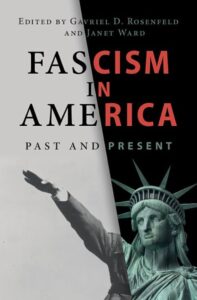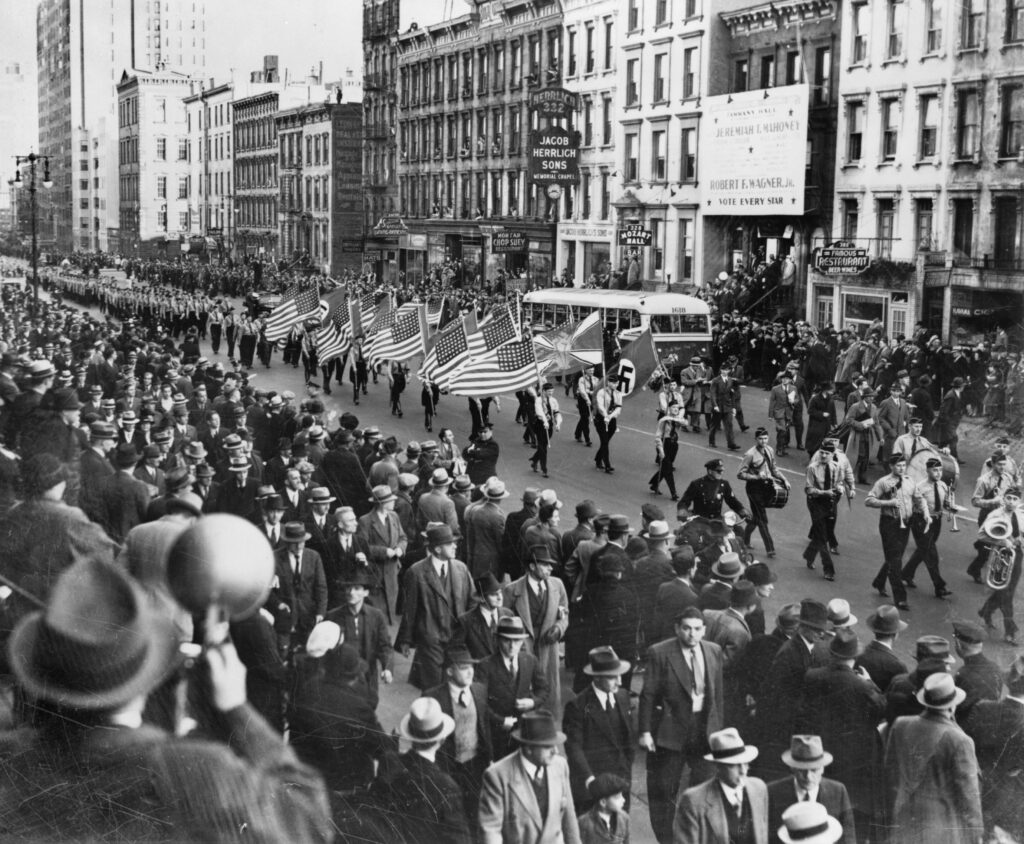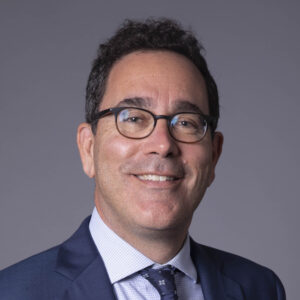“We Can No Longer Teach Fascism as Something Safely Tucked Away in the Past.”
Has fascism arrived in the United States? Will it soon? Or has it been living among us for many years? These are the questions that drive the twelve essays gathered in Fascism in America: Past and Present, a new collection edited by Gavriel Rosenfeld and Janet Ward, two prominent historians of the Holocaust.
Gavriel Rosenfeld, who teaches at Fairfield University, currently heads up the Center for Jewish History in New York. Janet Ward, a professor at the University of Oklahoma, recently served as president of the German Studies Association and as an American Council on Education fellow at Yale University.
 Your book combines essays that address urgent questions about the political present—specifically, how fascist Trumpism really is—with pieces on fascistic movements in the United States, from the KKK and Oregon vigilantes to the “America First” movement. Who is your intended audience?
Your book combines essays that address urgent questions about the political present—specifically, how fascist Trumpism really is—with pieces on fascistic movements in the United States, from the KKK and Oregon vigilantes to the “America First” movement. Who is your intended audience?
Janet Ward (JW): As academic historians, our default audience is normally academic. Yet here that’s not necessarily the case. We’ve always been aware that we operate in a concrete social and political context, of course. But since 2016 many of us have been compelled to consider more directly how our work can help sustain and protect democracy. That has also meant breaking down the barrier between academic and other audiences, as Timothy Snyder and others have done in recent years. Ultimately, speaking as a mother of teenagers, I would say that our intended audience is, through high school teachers, the generation of our children. The radicalization of American youth, especially during the Covid pandemic, is a worrisome development, as our contributor Cynthia Miller-Idriss, who runs the Polarization and Extremism Research Lab (PERIL) at American University, recently pointed out on NPR. This is why we very much hope that teachers—like those who ALBA works with—will use the material from the book.
Gavriel Rosenfeld (GR): Beyond targeting a multi-generational scholarly and lay audience, we also wanted to pitch the book to people interested in both European and U. S. history. We’re proud that scholars of German, Italian, and American history are represented in the volume. They bring a diverse set of perspectives to our topic.
You are both veterans of the field, but this feels like a new direction for you both.
JW: It’s true that both Gavriel and I have been teaching Nazi Germany and the history of the Holocaust since the groundswell of interest in those topics in the US in the early 1990s, with the opening of the US Holocaust Memorial Museum in Washington DC and the appearance of Spielberg’s Schindler’s List. But now it’s thirty years later, and the ground has shifted. If we don’t want the Holocaust commemorative project to fail, we have to teach it differently.
What has changed?
JW: First of all, we’ve seen a right-wing radicalization of society. But we also have to account for the loss of first-person testimony, as the generation that lived through the Holocaust has been disappearing. The digitization of Holocaust memory has been crucial for upholding the historical record—but it can also reduce authenticity and be used to fabricate false evidence in the service of that same right-wing radicalization. The real shift, I think, is that we are no longer teaching the rise of mid-20th-century fascism as something safely tucked away in the past. Today, we’re teaching it as a present danger. In old-style Holocaust education, we used to assume that people would become more tolerant because they learned its history or visited a historical site of an atrocity. When a globalized extreme right is working with great success to build an alternative way of viewing those sites of evidence, this can no longer be taken for granted.
GR: And while it’s easy for us to think that Holocaust consciousness has been with us forever, it really is a recent phenomenon. Since the 1990s, the focus has been less on the way Hitler rose to power than on the expanding spectrum of victims of the Holocaust. That’s an important moral and humanitarian agenda, to be sure. Today, though, we need to communicate a better understanding of how Holocaust education links to how liberal democracies break down and how reinforcing their strength is linked to larger social movements, such as Black Lives Matter.
Many of your contributors identify the threats to democracy quite clearly in US history.
JW: Indeed. It’s no coincidence that Linda Gordon’s chapter on the Ku Klux Klan is called “The American Fascists.” Bradley Hart’s essay shows how elected US officials were directly recruited by fascism in the 1930s. Richard Steigmann-Gall writes about the Silver Shirts, an American-born fascism movement. Matthew Specter and Varsha Venkatasubramanian trace the history of “America First,” a term whose prehistory most people are not familiar with. When the alt-right rally in Charlottesville in 2017 shouted “The Jews will not replace us,” most people don’t understand that this wasn’t simply a phrase imported from Nazi Germany but one that drew on longstanding American traditions of antisemitism and anti-immigration.
GR: In addition to the historically focused chapters that Janet mentioned, other chapters address how the present-day discourse on fascism—the recent “fascism debate”—has shaped contemporary perceptions of our present political moment. Thomas Weber’s and Ruth Ben-Ghiat’s contributions directly discuss Trump’s relationship to fascism. Marla Stone’s essay addresses the debate about whether ex-President Trump’s migrant detention centers on the U. S.-Mexico border were akin to “concentration camps.” And my own essay on the counterfactual depiction of Nazis taking over America in recent big budget streaming series (The Plot Against America, The Man in the High Castle, etc.) shows how fears of fascism are pervading today’s cultural discourse.
In the introduction you explain that the book was born out of several scholarly meetings, including a three-day seminar in Portland.
GR: This was at the German Studies Association meeting in 2019. Our goal was to compare historical Nazism with what was going in the United States at the time, in a first attempt to bridge the gap between scholars working on Germany and those working on the US.
It can’t have been a coincidence that this happened three years into the Trump presidency. Geoff Eley, in the opening chapter, builds a nuanced case for the use of the term “fascism” to understand political phenomena in the US and the world today. Still, as good historians, in your introduction you warn against “presentism,” the temptation to overemphasize the parallels between the past and the present at the expense of historical rigor.
GR: That’s why it’s so important that all twelve essays, each in different ways, focus on the actual historical origins of American fascism. Of course, we all grapple with the inevitable political aspects, not to mention the emotions, that come with the topic. But these are real debates in which our contributors take different positions. As editors, we’ve purposely avoided doing that. Instead, we have done our best to explain what those different positions look like, what the agendas are, and what’s ultimately at stake.
Still, some of the central points of the debate may seem less than relevant to a non-academic audience. I’m thinking of the nitpicking about the precise definition of “fascism,” for example. Or the question of whether fascism should be considered a foreign import or a home-grown American ideology.
JW: I’d say that second question in particular is quite relevant beyond the academy. The notion that what gave rise to Nazi Germany is something extraneous to American identity is a stumbling block to understanding both German and American history. We now know, for example, that native-born American eugenics and immigration laws exerted influence on the genesis of Nazi war crimes in Germany. The same is true for the Nuremberg Race Laws that created the platform for those crimes, and which, as James Whitman and others have shown, were modeled on American race law. What happened in Nazi Germany and in the Second World War was not an outside danger that Americans overcame by becoming actively involved as Allies.
GR: At the same time, you can’t overstate that argument either, because that might risk letting the Germans off the hook by ignoring what was specific to German history. It’s a question of emphasis and balance. When we talk about American fascism and its origins, we are not discovering entirely unknown territory. It’s just that now we have a more urgent political context for the public at large. The stakes are higher, and these debates have gained a new relevance.
Speaking of relevance: How do you imagine high school teachers addressing these topics in any of the states that have now adopted laws that ban the teaching of “divisive topics”? “The origins of American fascism” strikes me as pretty divisive.
JW: I, for one, think there are ways in which teachers can teach this material without running afoul of those new laws. For example, by focusing on first-person and historical newspaper sources and providing students with structured questions about those sources. Another approach that has long been successful in Holocaust museums is to understand history through the first-person experience of a child. That’s one way for teachers to steer clear of direct connections with partisan or politically divisive questions in the present—for example, who was on the right or wrong side in the storming of the Capitol on January 6, 2021.
You are both Germanists. What did you learn from your Americanist colleagues?
GR: I really appreciated how Bradley Hart challenged the deterministic underpinnings of the “good war” narrative—according to which American democracy was more or less destined to triumph over German fascism—by showing how an alarmingly large number of U. S. officials were sympathetic to Nazi ideas and betrayed American democracy by working with the Third Reich.
JW: I’ve learned a lot about the history of Black antifascist activism in the US, which Anna Duensing and Ousmane Power-Greene discuss in their contributions. I also learned from Alexander Reid Ross’ analysis of the long history of vigilantism in Oregon.
The accounts from Black volunteers in the Lincoln Brigade we use in ALBA’s professional development workshops show that African Americans’ experience with segregation and racial terror in the US allowed them a much clearer understanding than most other Americans of the dangers of German, Italian, and Spanish fascism—and how to respond to it. As historians, what would you say is the best protection against the fascist threat? Is a principled defense of liberal democracy enough? Or is liberalism too easily tempted into complacency or complicity with fascism if it’s not held to account by more militant forms of antifascism to its left?
GR: The connection between fascism and liberalism is a fascinating historical question. Is fascism an outgrowth of liberalism, or is it more rooted in the efforts of conservatives to torpedo the liberal system against the wishes of liberals? But it’s not a question that our book really gets into.
JW: Well, if the final years of the Weimar Republic show us one thing, it’s that arguments among the Left didn’t help it respond to the rise of fascism in an efficient or effective way. That’s a lesson we should probably heed.
GR: I’m very sympathetic to the idea that militancy has to be a part of the response, and yet I want to maintain an open mind about the complications. Looking at all these chapters about the 1930s, I’m heartened by the fact that, at least in the Popular Front era, liberals and leftists did work profitably together to stop fascism in its tracks.
Sebastiaan Faber, the chair of ALBA’s Board, teaches at Oberlin College.















